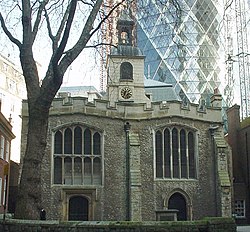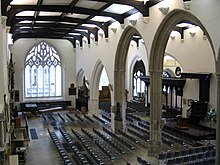St Helen's Church, Bishopsgate
| St Helen's Bishopsgate | |
|
London, Middlesex | |
|---|---|
 St Helen's Bishopsgate pictured in 2006 | |
| Church of England | |
| Diocese of London | |
| Location | |
| Location: | 51°30’53"N, 0°4’54"W |
| Address: | Great St Helen's |
| History | |
| Information | |
| Website: | st-helens.org.uk |
St Helen's Bishopsgate is a large Church of England church in the City of London, located in Great St Helen's, off Bishopsgate.
St Helen's is the largest surviving parish church in the City and it contains more monuments than any other church in the Diocese of London except Westminster Abbey, for which reason it is sometimes referred to as the "Westminster Abbey of the City".
This was the parish church of William Shakespeare when he lived in the area in the 1590s.[1][2] In 1608, prominent jurist Sir Alberico Gentili was buried in the church.
The church is designated a Grade I listed building.[3]
History
The church of St Helen dates from the 13th century and a priory of Benedictine nuns was founded there[4] in 1210.[5] It is unusual in that it was designed with two parallel naves, giving it a wide interior.[6] Until the dissolution of the priory in 1538, the church was divided in two by a partition running from east to west, the northern half serving the nuns and the southern the parishioners.[5] It is the only building from a nunnery to survive in the City of London.
The priory had extensive monastic buildings; its hall was later used by the Worshipful Company of Leathersellers until its demolition in 1799. A crypt extended north from the church, under the hall.[5]
In the 17th century two Classical doorcases were added to the otherwise Gothic church.[5][7] In 1874 the parish was united with that of St Martin Outwich when the latter's church was demolished, and the first incumbent of the new parish was John Bathurst Deane. St Helen's church was heavily restored by John Loughborough Pearson in 1891–1893, and reopened on St John the Baptist's Day in 1893 by the Bishop of London, Frederick Temple.

St Helen's was one of only a few City of London churches to survive both the Great Fire of London of 1666 and the Blitz during the Second World War.[8] However the church was badly damaged by the IRA in the Baltic Exchange bombing of 1992 and the Bishopsgate bombing of 1993.[9] The roof of the building was lifted and one of the City's largest mediæval stained glass windows was shattered. The church has since been fully restored although many of the older monuments within it were entirely destroyed. The architect Quinlan Terry, an enthusiast of Georgian architecture, designed the restoration along Reformation lines.
The natural philosopher, architect and polymath, Robert Hooke, was buried at St Helen's Bishopsgate, but the precise location of his grave is unknown.
Present day
Owing to parish consolidation over the years, the parish is now named "St Helen's Bishopsgate with St Andrew Undershaft and St Ethelburga Bishopsgate and St Martin Outwich and St Mary Axe". The Worshipful Company of Merchant Taylors are the patrons of the benefice.
St Helen's has been involved in numerous evangelical church planting initiatives in recent years, some within the auspices of the Church of England, some outside of it.[10]
Organ
The organ dates from 1744 when an annuity organ by Thomas Griffin was installed. It has undergone several restorations since by builders such as George Pike England in 1810, J. C. Bishop and Son in 1910 and 1923, Hill, Norman and Beard in 1929 and 1957, and Martin Goetze & Dominic Gwynn in 1996. A specification of the organ can be found on the National Pipe Organ Register.
The organ is of notable historic significance and has been awarded a Grade II* listing by the British Institute of Organ Studies.
Outside links
| ("Wikimedia Commons" has material about St Helen's Church, Bishopsgate) |
References
- ↑ Hales 1904, pp. 401–2.
- ↑ In Search of Shakespeare. Bishopsgate
- ↑ National Heritage List 1286458: St Helen's Bishopsgate
- ↑ "The City Churches" Tabor, M. p37:London; The Swarthmore Press Ltd; 1917
- ↑ 5.0 5.1 5.2 5.3 Godwin, George and Briton, John:: 'The Churches of London: A History and Description of the Ecclesiastical Edifices of the Metropolis' (C. Tilt, 1839)}}
- ↑ "London:the City Churches” Pevsner,N/Bradley,S New Haven, Yale, 1998 ISBN 0-300-09655-0
- ↑ Nairn, Ian. Nairn's London. Harmondsworth: Penguin Books. p. 28.
- ↑ "The Old Churches of London" Cobb,G: London, Batsford, 1942
- ↑ "The Visitors Guide to the City of London Churches" Tucker,T: London, Friends of the City Churches, 2006 ISBN 0-9553945-0-3
- ↑ St Helen's Bishopsgate: about us
- Hales, John W. (January–June 1904). "London Residences of Shakespeare". The Athenaeum (London: John C. Francis): 401–2. https://archive.org/stream/p1athenaeum1904lond#page/400/mode/2up. Retrieved 8 December 2013.
